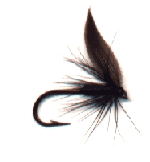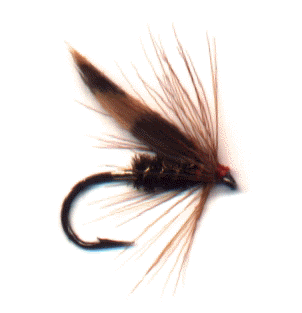The Clyde Style
Been a while since I did this, thought it might be of interest to some, so here goes with the first of the year. By way of a journal entry, I hope you like it.
"The trout within yon wimpling burn. Glides swift- a silver dart. And safe beneath the shady thorn. Defies the anglers art....Robert Burns
The River Clyde & it's tributaries tumble westward from above Elvanfoot through village & skirting the market towns of Lanark & Hamilton empties via Glasgow City into the Firth of Clyde at Greenock. The lower Clyde in past times was more famous for shipbuilding & engineering, John Browns, Scott Lithgow, Fairfield & Howden Eng. a few greats from the past. Here the great Cunard Queens were built Elizabeth & Mary, the vast steel mills at Ravenscraig. Clyde built meant quality & these tough men had a pride in their craft but sadly with the demise of heavy engineering the Clyde shipyards are now fading into obscurity the Steel men have moved on to other things but the style remains.
But it is not shipbuilding we talk off here, it is the upper Clyde the fishing, tactics & most important of all its unique flies that is The Clyde Style. Typical of the marque, hooks are light wired body length no more than half the shank, hackle of hen or upland game bird 1 to 2 turns only. Wings are in the main tied upright at a "jaunty wee angle." Lightness of construction sombre & hooking properties are good. Look at a natural olive on the wing on a summers morning. Look how big it looks as the sun glistens on it but catch one to hand & we are immediately taken by its fragility & beauty. That is what The Clyde Fly will imitate, will suggest. Not shop bought, bulky Border or loch flies but something more akin to nature.
A dark corner of a Clyde Wet Fly box
As fishing pressure increased in the 1900s these fly fishers soon realised that it was a lighter dressed fly that would give them any success & whilst these flies may hark back as far as the18th century they were more than likely in those early days to be of a more robust appearance.
These steel men of Lanark & district haunted the upper reaches of the river. Abington, Crawford & Lamington districts were favoured starting points on the river. Every Saturday the south bound bus from Glasgow held many of these fishers & they were duly deposited at their favourite spots along the river. They were legendary whether with Gadger (Stonefly Nymph) or The Baggie (Minnow) Trout were hard to catch, no C&R here, this was fishing for the pot, only undersized fish were returned & then only till they were big enough to be caught again.
The fly fishers using locally procured fur & feathers fashioned their flies often "sans vice". Maybe a turn of silver tinsel or gold twist but nothing else adorned the somewhat drabness. Indeed in my youth I was first taught to tie a wee flee by hand. I remember my Dad talking me to night classes at Govan High School Glasgow when I was about 12yrs old quote from my mother at the time "To keep me off the streets". My first fly tying case indeed was a discarded Xmas biscuit tin. Luckily for me at least there were one or two Clyde tiers there & that was the kick start I needed.
Blae & Black size 16, a simple wet to show "Style"
Thankfully today fishing trends have changed & people are becoming more aware of the need to conserve fish stocks. If not through out and out C&R, at least in bag limits. The old flies are gradually being replaced by today's modern patterns, Comparaduns & CDC are the more likely offerings but a hard core of knowing fly fishers still adhere to the old stuff. If a fly is good, time will not diminish it, it is still a good fly whatever water it alights.
Tackle involves a longish soft action rod coupled with a single action reel & 3/4wt floating line & appropriate backing although a sinking tip or braids are useful for deeper water. Yesterdays Greenheart & Split Cane (bamboo) gave way to glass fibre & the light carbon wands of todays fly fishers. Modern carbon rods to not lend themselves too well to downstream wet as they are far too stiff. A good wet fly rod is hard to find in carbon & indeed Wet fly is "The Forgotten Taper" Having said that though not new I see a USA in particular trend to lighter switch rods so maybe a few of them might be suitable. I digress, traveling light is paramount in this style of fishing, and you can find yourself covering a good few miles of water in a day. To keep weight down to a minimum I find myself carrying braided leaders in varying densities to be a useful addition thus saving the need to carry spare spools & line. My trusty Brady bag, a few spools of Maxima light nylon, box of flies, snips, couple of sandwiches, a flask of coffee & a small towel for drying wet hands complete the picture.
A three fly setup is normal, mounted on a 10ft tippet with 6" blood knotted droppers. Tapered from 5lb down to 3lb is about right but if Trout are finicky I will taper from 4lb -2lb on point Surprisingly this is relatively tangle free if one can change from the fast & slick & adopt a more open loop style of casting. The old timers used up to 6 flies at a time & tangles were not a problem unless strong winds were present. Flies set up this way, are called "a cast" or a "team" and are fished on short line down & across searching out likely trout holding spots. A lot of water can be covered in a days fishing hence keeping weight to a minimum is desirable. After all you may "have" to leave room for a few trout for breakfast. Flies them self have simple names & in the main are taken from the materials used to tie them. Woodcock & Yellow & Startling Tip to name but two but now and again we get something interesting Reid's Assassin, wonder how many that Trout have fallen to that one & perhaps the best Clyde Fly of all The Hen Blackie which is in my opinion the finest wet suggestive pattern for an early spring olive there is.
All in all a most interesting way to fish & trout can be steadily taken in this style giving the right conditions. Blend in with your background study to be quiet & be quiet to study are the keywords. Approach cautiously & flick your flies on marginal water first before wading as trout can lie in surprisingly thin water. Lengthen your cast & fish across & down mending as conditions require. Move down a pace or two between casts always with the emphasis on stealth, no clumsy wading here or you will scare every trout in the stream shuffle rather than step. Allow flies to swing below, lift rod tip slowly & recast. Always anticipating a trout, for even at this late stage, having shown interest & followed the flies around may still snatch as you prepare to recast. Many are lost at this point, due to the difficulty of hooking directly below & down. Most takes though come as the flies begin to quicken up as they swing across & down. Try this technique in spring/early summer in fast to medium flows. The fly below is a night pattern, 12s are about right to match the beefier moths & Sedge one finds on a Scottish gloaming.
The Stank Hen, size 12 a typical gloaming or night fly but still retains "The Clyde Look""
Lastly, fish as light as you dare but more important fish to be quiet.
Hope you enjoyed my ramblings.
Alan The Highlander
Terminology:
Flee: As in fishing the flee (fly)
Blackie: Blackbird
Gadger: Nymph of a large Stonefly. Old time anglers caught them in fine mesh nets placed downstream of rock & gravel & the angler disturbs said & the nymphs are collected within the net. Used as bait can be a deadly way of fishing.
Baggie: The Minnow, like the Gadger a superb bait for Trout. Fished wobbled across the stream it generally attracted the larger fish.
Blae: Old Scots word, generally taken as a shade of bluey grey (u.s. Gray)
Stank: An enclosed water with no inlet out outlet flow. The Stank Hen is a Scots name for the bird Moorhen commonly found in this type of water. Its feathers are very soft & ideal for night time flies.







 Reply With Quote
Reply With Quote
